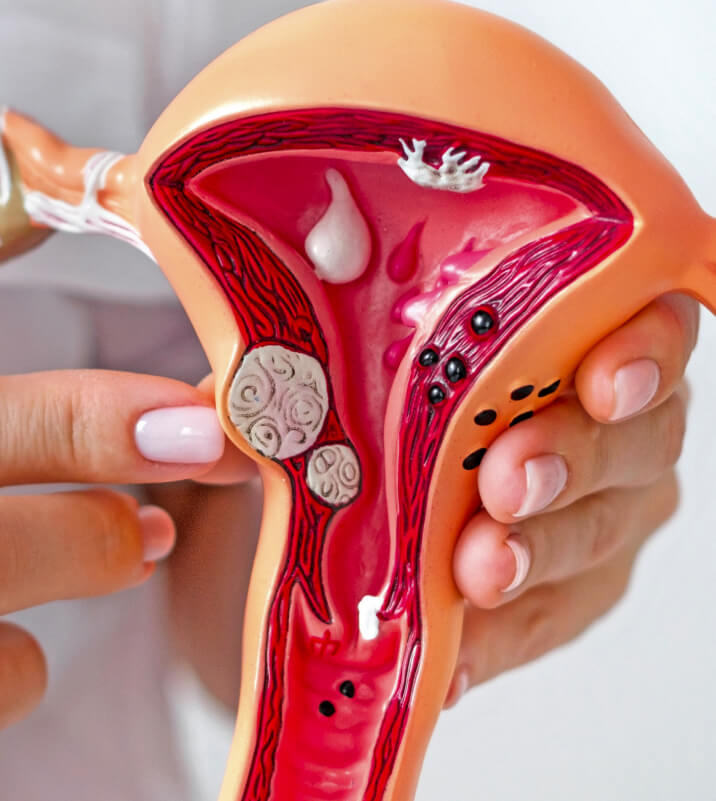What Are Uterine Fibroids?
Fibroids are typically non-cancerous growths of the uterine wall commonly found in women during their childbearing years. Fibroids may be classified according to their location within the uterus as:
- Subserous fibroids which grow in the outer wall of the uterus
- Intramural fibroids which grow within the inner wall of the uterus
- Submucosal fibroids which protrude into the cavity of the uterus
Depending on the location of the fibroids and size of the fibroids, there may be different symptoms. Submucous fibroids protruding or pressing into the cavity of the uterus may cause heavy or prolonged menstrual bleeding. Large subserous fibroids or large intramural fibroids may exert pelvic pressure or pain. Fibroids lying close to the bladder may cause frequent urination, or difficulty emptying the bladder. Fibroids lying at the back of the uterus close to the bowels may cause difficulty with defaecation or emptying of the bowels.
Occasionally, women may not have symptoms from fibroids and may be found to have fibroids only incidentally on physical examination when a large abdominal mass is detected.

What Are the Signs & Symptoms of Fibroids?
Many fibroids are asymptomatic, with some resolving on their own. However, depending on the size and location, signs and symptoms may include:
Heavy vaginal bleeding or a painful period
Prolonged menstruation
Discomfort or heaviness in the pelvis
Pain in the lower back
Pain while having sex
Bladder problems such as frequent urination
Spotting or bleeding between periods
Treatment will vary depending on the severity of symptoms, ranging from observation to uterine fibroid surgery in Singapore.
What are the Causes of Fibroids Development?
What exactly causes fibroids is still unknown. However, there are risk factors that can contribute to its development. These include:
Genetic predisposition:
Individuals with family members diagnosed with fibroids have a higher chance of developing one and may require fibroid surgery.Hormones:
Oestrogen is a female sex hormones that thickens the lining of the uterus during menstruation. This hormone can also promote fibroid growth. During the menopausal period, fibroid tumours shrink as the body produces fewer hormones.Obesity:
Fat cells in the body release oestrogen which may contribute to the growth of fibroidsHaving no previous pregnancies has been associated with an increased risk of fibroids
Vitamin D deficiency has also been linked to an increased risk of fibroids
Take the First Step Towards Your Health and Fertility Journey
— Schedule a Consultation at 6235 5066
Which Size of Fibroids Is Dangerous?
Fibroids in Singapore vary in size, and women with larger fibroids typically experience more serious symptoms. For instance, fibroids that measure 4 to 5 cm or more and develop inside the uterus can distort the womb’s shape and potentially block the fallopian tube. On the other hand, if it grows outside the uterus, it can press onto nearby organs and cause pain or discomfort.
Here are some factors that determine the type of uterine fibroids treatment needed:
- the nature of the symptoms e.g. severity of pain or heavy menstrual flow caused by fibroids
- the desire for fertility (usually done to prepare for IVF treatment).
- the size of the lesion
- the risk for cancerous changes in the fibroid
What are the Treatments Available for Uterine Fibroids?
Observation of fibroids
An ultrasound scan is usually useful for the diagnosis of fibroids and monitoring the size of fibroids.Medication for symptoms caused by fibroids
Medication may also be prescribed to reduce menstrual pain and also to reduce the amount of menstrual flow due to the fibroids.Surgery to remove fibroids
Myomectomy
Myomectomy refers to surgery to remove the fibroids alone, leaving the uterus in place to allow you to bear children. With myomectomy, as opposed to a hysterectomy, there is a risk of fibroid recurrence.The surgical approach to a myomectomy depends on the size and location of the fibroids as well as risk of cancerous change. Fibroids may be removed by laparoscopy (minimally-invasive or key-hole method) or laparotomy (open abdominal approach).Hysterectomy
Surgery to remove the uterus is the permanent solution for fibroids but ends your ability for childbearing. Hysterectomy may also be performed by laparoscopy or laparotomy.
Gynaecology Services We Provide
Share your concerns with us
Thank you for considering our clinic. For further information, feel free to contact us at 6235 5066 or submit your enquiry using the form below. We will get back to you promptly.


